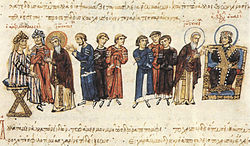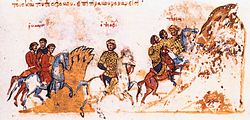- Manuel the Armenian
-
Manuel Born late 8th century Died 27 July 838 / ca. 860 Buried at Monastery of Manuel, Constantinople Allegiance Byzantine Empire, Abbasid Caliphate Rank protostrator, strategos of the Anatolics, Domestic of the Schools Battles/wars Battle of Anzen Relations Empress Theodora Manuel the Armenian was a prominent Byzantine general of Armenian origin, active from ca. 810 until his death in 838. After reaching the highest military ranks, a palace conspiracy forced him to seek refuge in the Abbasid court in 829. He returned to Byzantine service the next year, receiving the position of Domestic of the Schools. According to one report, he died on 27 July 838 of wounds received while saving the Emperor Theophilos from capture during the Battle of Anzen. Some chronicles however record his survival past this date and report that he died some time around 860. His niece, Theodora, became empress to Theophilos and ruled as regent for many years after Theophilos' death.
Contents
Life
Manuel was of Armenian origin, and the brother of Marinos, the father of the future empress Theodora.[1][2] Manuel first appears in the reign of Michael I Rangabe (r. 811–813), when he held the post of protostrator (head of the imperial stables). At the time, he must have been still young, probably in his twenties. Although he urged Michael to confront Leo the Armenian, following Michael's deposition by Leo (r. 813–820), Manuel was promoted to the rank of patrikios and entrusted with the post of strategos of the Armeniac or the Anatolic Theme. The latter was the most senior of the Empire's thematic governors and military leaders, and Leo himself had held the office prior to his accession.[3][4][5][6] According to historians J.B. Bury and Warren Treadgold, in early 819 and for about a year, the emperor seems to have appointed Manuel to the exceptional post of monostrategos ("single-general") of the five land themes of Asia Minor, but this unusual concentration of command authority was apparently directed towards the more effective suppression of iconophile resistance against Leo's reinstatement of Iconoclasm rather than for military purposes. This appointment is however most likely a misreading of the primary source, according to the editors of the Prosopographie der mittelbyzantinischen Zeit.[7][8] Manuel probably continued serving as strategos of the Anatolics under Michael II the Amorian (r. 820–829), although he is not explicitly mentioned.[4]
Escape to the Caliphate
 The embassy of John the Grammarian in 829 to Ma'mun (depicted left) from Theophilos (depicted right), as depicted in the Madrid Skylitzes
The embassy of John the Grammarian in 829 to Ma'mun (depicted left) from Theophilos (depicted right), as depicted in the Madrid Skylitzes
Shortly after the accession of Michael II's son and successor, Theophilos (r. 829–842) however, Manuel defected to the Abbasids as a result of machinations at court: the logothetes tou dromou (foreign minister) Myron had accused him to the emperor of plotting to seize the throne. Theophilos was hesitant to believe the accusations, and was eventually convinced by the protovestiarios (chamberlain) Leo Chamodrakon and the synkellos John the Grammarian of his general's innocence.[4][9] Manuel however did not wait for the emperor's judgement. Using the carriages of the imperial post he crossed Asia Minor in haste and offered his services to Caliph al-Ma'mun (r. 813–833), on condition that he would not be forced to convert to Islam. Theophilos in turn resolved to get him to return and sent John the Grammarian to Baghdad on a diplomatic mission, ostensibly in order to announce his accession. John was indeed able to see Manuel in private and offered him the Emperor's pardon, which Manuel seemed to accept.[10]
In the summer of 830 however, Manuel participated in an Arab expedition against the Khurramite rebels of Babak Khorramdin in Azerbaijan, alongside a contingent of Byzantine captives. The campaign was nominally led by Ma'mun's own son, al-'Abbas, but W. Treadgold believes that Manuel was the actual commander. After winning a few modest successes, the army turned back south. Manuel, who by then had probably won the confidence of his Arab minders, suggested that he and 'Abbas take a part of the army and raid over the Pass of Adata into Byzantine Cappadocia. Once across the mountains, he and the other Byzantine captives escaped, taking with them the arms of 'Abbas and his escort, who were however allowed to get back unmolested.[11]
Domestic of the Schools
Theophilos welcomed Manuel with open arms, and named him magistros and Domestic of the Schools, commander of the elite tagmata regiments. Manuel would remain Theophilos' leading general for the remainder of his life. As the uncle of Theophilos' new wife, the Empress Theodora, his position at court was now unassailable. It is indicative that the emperor later served as godfather for Manuel's children.[4][12]
In 831, Manuel accompanied Theophilos in an expedition against a raid by the Cilician Arabs. The Byzantines caught up with the Arabs near the fort of Charsianon, and inflicted a heavy defeat upon them, killing 1,600 and taking some seven thousand prisoner.[13] Manuel is also recorded as accompanying Theophilos on his great expedition in 837 against the Arab cities of northern Mesopotamia, which led to the sack of Zapetra and Arsamosata.[4][14] This campaign however, and the atrocities committed by the Byzantines after the fall of Zapetra, provoked a large-scale retaliatory campaign by Caliph al-Mu'tasim (r. 833–842). Manuel again accompanied the emperor as his senior general, along with Theophobos, the commander of the large "Persian" corps, composed of Khurramite refugees. He participated in the disastrous Battle of Anzen on 22 July 838, where Theophilos confronted the army of general al-Afshin.[15] During that battle, the imperial army broke and fled, and Theophilos with his retinue was surrounded by the Arabs on a hill with some 2,000 "Persians". When some of the latter reportedly began planning to surrender the emperor to the Arabs, Manuel seized the emperor's horse by the bridle and forcibly led him away. With a few other officers he managed to break through the Arab lines, and brought Theophilos to safety in the nearby village of Chiliokomon.[16] During this he received heavy wounds, and according to the chronicle of Symeon Logothetes, he died of them soon after, likely on 27 July. He was buried in his palace in Constantinople, which lay near the cistern of Aspar and which became a monastery named after him, now traditionally identified with the Kefeli Mosque.[4][8][17][18]
Possible life after 838
The chronicles of Genesios and Theophanes Continuatus (and following them Skylitzes and Zonaras) however report that he survived his wounds, allegedly after renouncing iconoclasm at the behest of some monks. He is further said to have been appointed a member of the regency council for Michael III (r. 842–867) along with Theoktistos and Bardas, and to have refused the position of emperor when the populace acclaimed him thus at the Hippodrome. The same writers report that he played an important role in the restoration of the icons, and that he became a protomagistros before falling out with Theoktistos and retiring. According to the same sources, in the late 850s, he saved the emperor's life in another battle at Anzen and died shortly after.[19][20][21][22] Older scholars largely accepted this account, but modern historians have expressed doubts as to its veracity. Henri Grégoire was the first to highlight its incompatibility with the narrative of Symeon Logothetes, speculating that it was a later invention, possibly carried out by the monks of the Monastery of Manuel, who venerated him as a saint and tried to mitigate his iconoclast past. Warren Treadgold, who considers Symeon Logothetes more reliable, also dismissed the reports of Manuel's post-838 survival as invented.[4][21][23]
Other historians support the possibility of his continued life after 838, especially given the existence of a seal, dated to the mid-9th century, which names "Manuel patrikios, imperial protospatharios, magistros and bagulos[24] of the emperor", which seems to confirm both his survival into at least the early years of Michael III's reign, and his reported role as a member of the regency. Even so, the stories about his activities, and in particular his role in the restoration of the icons and the alleged second battle at Anzen (which is clearly inspired by the events of 838), are regarded as almost certainly fictitious. However, it may be that the story of his death after Theoktistos' downfall is reliable, which would probably place it sometime between 855 and 863.[25]
References
- ^ Treadgold (1988), p. 269
- ^ Winkelmann et al. (1998), p. 136
- ^ Guilland (1967), p. 436
- ^ a b c d e f g Kazhdan (1991), p. 1289
- ^ Treadgold (1988), p. 198
- ^ Winkelmann et al. (1998), pp. 136, 140
- ^ Treadgold (1988), p. 222
- ^ a b Winkelmann et al. (1998), p. 140
- ^ Treadgold (1988), p. 267
- ^ Treadgold (1988), pp. 267–268
- ^ Treadgold (1988), pp. 272–273
- ^ Treadgold (1988), p. 273
- ^ Treadgold (1988), p. 275
- ^ Treadgold (1988), pp. 293ff.
- ^ Treadgold (1988), pp. 297–300
- ^ Treadgold (1988), p. 300
- ^ van Millingen (1912), pp. 252–257
- ^ Treadgold (1988), p. 301
- ^ Guilland (1967), p. 437
- ^ van Millingen (1912), pp. 255–256
- ^ a b Treadgold (1979), pp. 180–183
- ^ Winkelmann et al. (1998), p. 138
- ^ Treadgold (1988), pp. 389, 452
- ^ A term meaning "mentor, preceptor". Kazhdan (1991), p. 245
- ^ Winkelmann et al. (1998), pp. 140–141
Sources
- Guilland, Rodolphe (1967) (in French), Recherches sur les institutions byzantines, Tome I, Berlin: Akademie-Verlag
- Kazhdan, Alexander, ed (1991). Oxford Dictionary of Byzantium. Oxford University Press. ISBN 978-0-19-504652-6.
- Treadgold, Warren T. (1979). "The Chronological Accuracy of the "Chronicle" of Symeon the Logothete for the Years 813–845". Dumbarton Oaks Papers (Dumbarton Oaks) 33: 157–197. JSTOR 1291437.
- Treadgold, Warren T. (1988), The Byzantine Revival, 780–842, Stanford, CA: Stanford University Press, ISBN 978-0-8047-1462-2
- Van Millingen, Alexander (1912). Byzantine Churches of Constantinople. London: MacMillan & Co.
- Winkelmann, Friedhelm; Lilie, Ralph-Johannes et al. (1998). "Manuel (#4707)" (in German). Prosopographie der mittelbyzantinischen Zeit: I. Abteilung (641–867), 3. Band: Leon (#4271) – Placentius (#6265). Walter de Gruyter. pp. 136–141. ISBN 978-3-11-016673-9. http://books.google.gr/books?id=wtLm7NLZJ5wC&lpg=PP1&hl=en&pg=PA136#v=onepage&q&f=false.
Categories:- 8th-century births
- 9th-century deaths
- 9th-century Byzantine people
- Byzantine Armenians
- Byzantine generals
- Byzantine defectors
- Patricii
- Byzantine people of the Byzantine–Arab Wars
- Abbasid generals
Wikimedia Foundation. 2010.

